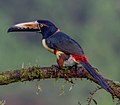Loading AI tools
Genus of birds From Wikipedia, the free encyclopedia
An aracari or araçari (US: /ˌɑːrəˈsɑːri/ AR-ə-SAR-ee,[1] UK: /ˌærəˈsɑːri/ ARR-ə-SAR-ee, /-ˈkɑːri/ -KAR-ee)[2] is any of the medium-sized toucans that, together with the saffron toucanet, make up the genus Pteroglossus.
| Aracaris | |
|---|---|
 | |
| Pale-mandibled aracari Pteroglossus erythropygius | |
| Scientific classification | |
| Domain: | Eukaryota |
| Kingdom: | Animalia |
| Phylum: | Chordata |
| Class: | Aves |
| Order: | Piciformes |
| Family: | Ramphastidae |
| Genus: | Pteroglossus Illiger, 1811 |
| Type species | |
| Ramphastos aracari (black-necked aracari) Linnaeus, 1758 | |
| Species | |
|
14 (incl. the saffron toucanet), see text. | |
| Synonyms | |
|
List
| |
They are brightly plumaged and have enormous, contrastingly patterned bills. These birds are residents in forests and woodlands in the Neotropics.
The genus Pteroglossus was introduced in 1811 by the German zoologist Johann Karl Wilhelm Illiger.[3] The name combines the Ancient Greek pteron meaning "feather" with glōssa meaning "tongue".[4] George Robert Gray designated the black-necked aracari as the type species of the genus in 1840.[5][6]
The name "Aracari" was used in 1648 by the German naturalist Georg Marcgrave for the black-necked aracari in his book Historia Naturalis Brasiliae.[7] The name comes from the word Arassari, the name of the bird in the Tupi language.[8]
One species, the distinctive saffron toucanet, was formerly placed in the monotypic genus Baillonius, but Renato Kimura and collaborators showed in 2004 that it belongs in the genus Pteroglossus.[9][10]
A 2010 molecular phylogenetic study by Swati Patel and collaborators found that the brown-mandibled aracari was nested with the subspecies of the ivory-billed aracari:[11]
| Pteroglossus |
| ||||||||||||||||||||||||||||||||||||||||||||||||||||||||||||||||||||||||||||||||||||
Fourteen species are considered to belong to the genus Pteroglossus:[12]
| Image | Scientific name | Common Name | Distribution |
|---|---|---|---|
 | Pteroglossus viridis | Green aracari | lowland forests of northeastern South America (the Guiana Shield), in the northeast Amazon Basin, the Guianas and the eastern Orinoco River drainage of Venezuela |
 | Pteroglossus inscriptus | Lettered aracari | Bolivia, Brazil, Colombia, Ecuador, and Peru |
 | Pteroglossus bitorquatus | Red-necked aracari | Bolivia and Brazil |
 | Pteroglossus azara | Ivory-billed aracari | Bolivia, Brazil, Colombia, Ecuador, Peru, and Venezuela |
 | Pteroglossus mariae | Brown-mandibled aracari | Bolivia, Brazil, and Peru |
 | Pteroglossus aracari | Black-necked aracari | Brazil, French Guiana, Guyana, Suriname, and Venezuela |
 | Pteroglossus castanotis | Chestnut-eared aracari | Amazon Basin, Paraguay, Bolivia, southeastern Brazil and the extreme northeast of Argentina |
 | Pteroglossus pluricinctus | Many-banded aracari | Brazil, Colombia, Ecuador, Peru, and Venezuela |
 | Pteroglossus torquatus | Collared aracari | southern Mexico to Panama; also Ecuador, Colombia, Venezuela and Costa Rica |
 | Pteroglossus sanguineus | Stripe-billed aracari | Colombia and Ecuador |
 | Pteroglossus erythropygius | Pale-mandibled aracari | Ecuador and Peru |
 | Pteroglossus frantzii | Fiery-billed aracari | southern Costa Rica and western Panama |
 | Pteroglossus beauharnaisii | Curl-crested aracari | Amazon Basin |
 | Pteroglossus bailloni | Saffron toucanet | Brazil |
Some authorities, either presently or formerly, recognize additional species or subspecies as species belonging to the genus Pteroglossus including:
Some species of aracaris are unusual for toucans in that they roost socially throughout the year, up to six adults and fledged young sleeping in the same hole with tails folded over their backs.
They are arboreal and nest in tree holes laying 2–4 white eggs.
All the species are basically fruit-eating, but will take insects and other small prey.
The ischnoceran louse Austrophilopterus flavirostris is suspected to parasitize most if not all species of aracaris, with the possible exception of the green aracari (Price & Weckstein 2005).
Seamless Wikipedia browsing. On steroids.
Every time you click a link to Wikipedia, Wiktionary or Wikiquote in your browser's search results, it will show the modern Wikiwand interface.
Wikiwand extension is a five stars, simple, with minimum permission required to keep your browsing private, safe and transparent.